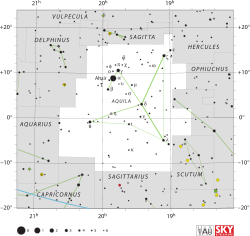Nu Aquilae

| |
| Observation data Epoch J2000 Equinox J2000 | |
|---|---|
| Constellation | Aquila |
| Right ascension | 19h 26m 31.09000s[1] |
| Declination | +00° 20′ 18.8521″[1] |
| Apparent magnitude (V) | 4.646[2] |
| Characteristics | |
| Spectral type | F3 Ib[3] |
| U−B color index | +0.592[2] |
| B−V color index | +0.593[2] |
| R−I color index | 0.46 |
| Astrometry | |
| Radial velocity (Rv) | –1.0[4] km/s |
| Proper motion (μ) | RA: +0.57[1] mas/yr Dec.: –2.31[1] mas/yr |
| Parallax (π) | 1.15 ± 0.27[1] mas |
| Distance | approx. 2,800 ly (approx. 900 pc) |
| Absolute magnitude (MV) | –5.0[3] |
| Details | |
| Mass | 10.6[3] M☉ |
| Radius | 78[3] R☉ |
| Luminosity | 11,800[3] L☉ |
| Temperature | 6,900[3] K |
| Metallicity | 7.47[3] |
| Rotational velocity (v sin i) | 13[5] km/s |
| Age | 15[3] Myr |
| Other designations | |
Nu Aquilae (ν Aql, ν Aquilae) is the Bayer designation for a solitary[7] star in the constellation of Aquila and lies close to the celestial equator. It has an apparent visual magnitude of 4.646[2] and so is visible to the naked eye. Based upon an annual parallax shift of only 1.15 mas (with a 23% margin of error),[1] it is approximately 2,800 light-years (860 parsecs) from Earth.
The spectrum of this star matches a stellar classification of F3 Ib,[3] with the luminosity class of Ib indicating this is a supergiant. It has over twelve times the mass of the Sun and 78 times the Sun's radius. The outer atmosphere has an effective temperature of 6,900 K and it is radiating 11,800 times as much light as the Sun.[3] At this heat, it has the yellow-white hue of an F-type star.[8]
References
- ↑ 1.0 1.1 1.2 1.3 1.4 1.5 van Leeuwen, F. (November 2007), "Validation of the new Hipparcos reduction", Astronomy and Astrophysics 474 (2): 653–664, arXiv:0708.1752, Bibcode:2007A&A...474..653V, doi:10.1051/0004-6361:20078357.
- ↑ 2.0 2.1 2.2 2.3 Gutierrez-Moreno, Adelina et al. (1966), A System of photometric standards 1, Publicaciones Universidad de Chile, Department de Astronomy, pp. 1–17, Bibcode:1966PDAUC...1....1G.
- ↑ 3.0 3.1 3.2 3.3 3.4 3.5 3.6 3.7 3.8 3.9 Lyubimkov, L. S. et al. (2010). "Accurate fundamental parameters for A-, F- and G-type Supergiants in the solar neighbourhood". Monthly Notices of the Royal Astronomical Society 402 (2): 1369–1379. arXiv:0911.1335. Bibcode:2010MNRAS.402.1369L. doi:10.1111/j.1365-2966.2009.15979.x.
- ↑ Wilson, Ralph Elmer (1953), General Catalogue of Stellar Radial Velocities, Washington: Carnegie Institution of Washington, Bibcode:1953QB901.W495......
- ↑ Bernacca, P. L.; Perinotto, M. (1970), "A catalogue of stellar rotational velocities", Contributi Osservatorio Astronomico di Padova in Asiago 239 (1), Bibcode:1970CoAsi.239....1B.
- ↑ "32 Aql -- Star in double system", SIMBAD Astronomical Object Database (Centre de Données astronomiques de Strasbourg), retrieved 2012-07-19.
- ↑ Eggleton, P. P.; Tokovinin, A. A. (September 2008). "A catalogue of multiplicity among bright stellar systems". Monthly Notices of the Royal Astronomical Society 389 (2): 869–879. arXiv:0806.2878. Bibcode:2008MNRAS.389..869E. doi:10.1111/j.1365-2966.2008.13596.x.
- ↑ "The Colour of Stars", Australia Telescope, Outreach and Education (Commonwealth Scientific and Industrial Research Organisation), December 21, 2004, retrieved 2012-01-16
External links
| ||||||||||||||||||||||||||||||||||||||||||||||||||||||||||||||||||||||